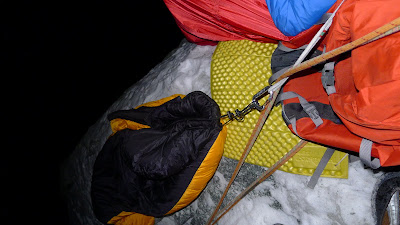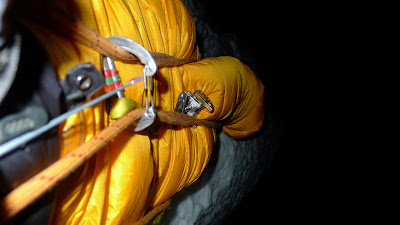Inspiration is for sure live broadcasted from Tommy Cadwells attempt to send his long time project Dawn Wall on El Cap. If he manage to pull it off this year it will for sure represent a quantum leap forward in terms of free big wall climbing. Sadly his long time partner on the project is not there as Kevin got injured on the dyno problem. I really hope Tommy finish this one after spending about some 80 days (I think) working it.
For live updates:
Sunday, 30 October 2011
Thursday, 27 October 2011
Sport climbing in the sun
The fall season is just getting started and I feel stronger again after a few hard indoor sessions as well as a few really good outdoor sessions despite 25 cm of fresh snow on the ground. Its time to get the draws up on a project and send the first 8a/8a+ of the year. Tarn, Tres Ponts, St Leger or Ceuse?
Photo: Sending a endurance 7B





Photo: Sending a endurance 7B





Saturday, 22 October 2011
Town to Town push in Zermatt

Photo: http://www.wenger.ch
The past week was "hot" in many ways on Matterhorn with huge traffic early in the week. For me a bit to much with 9 guys heading up the North Face the same day. In the end we did a light town to town push, climbing the Schmid route in 5 hours 45 minutes from the approximate level of the Hurnli Hut to the summit and then back down to the running shoes we had stashed a few hundred meters under the Hurnli hut. Having been there earlier in the week I knew a light rack and single rope was the way to go. We simul climbed/soloed the route in 4 blocks from the Bergschrund. This was my second trip up the North Face, kast one was in winter and then we did it 12h from Hornli hut to Solvay hut. It was faster with less snow as it was more clear as where to go. Sdly a climber lost his life on the route during the sunday of that week. May his partner recover and he R.I.P
Monday, 10 October 2011
Bonatti-Vaucher on Grandes Jorasses and the rescue

When Walter Bonatti passed away I was climbing the Swiss route on Cima Ovest with Helen and one thought that popped up in my head directly was to pay my respect to the great Bonatti by trying to repeat his little known master piece on the North Face of Grandes Jorasses. Situated between Pointe Whymper and Pointe Croz this part of the face is the home to some of the hardest mixed routes in the Alps such as No Siesta.
With a huge weather window open and the word spreading that No Siesta had been climbed by Korra Pesce/Jeff Mercier and Jonathan Griffit/Will Sim (including a number of other routes on various aspects of the face) the idea to go and try the Bonatti-Vaucher felt like a no brainier. In the guide book the route is described by Francois Marsigny as "More difficult than the McIntyre and easier than No Siesta". That's quite a grade range and quite an understatement as the Bonatti-Vaucher is much more sustained than the McIntyre. The route has seen very little traffic to date and might have as few known repeats as six in total.
We approached the wall in 4 hours on Monday the 3rd and felt super motivated. It was such a calming feeling to finally be off after all mental preparations. My partner had done both the North Face of Eiger (11th time up the NF of Eiger) and the North Face of Matterhorn with in the last week so we split the work load in to two parts where he would lead the "cardio" (little did we know there was really no such parts...) stretches of the route and I would do the technical pitches.

We departed our bivy at the base of the wall just before 7 am and made rapid progress up the first part of the route that seams to be the same as the start of No Siesta judging from tracks and pictures I've seen on Will Sim's blog. The conditions where not too bad and the "info" was that the upper parts would be in even better conditions, so thing looked good. But as we all know two different routes on the same face is never the same...
The climbing is exceptionally good on steep mixed ground with only one short section of slugging so always interesting and full on real climbing. As soon as you pass the traverse out left the route starts to bite back for real with some very sustained and interesting mixed and dry tooling. The upper parts are hard for the grade in my opinion and relatively exposed compared to other routes in the same grade range. The top section, at the same level as the crux on No Siesta some 50 or 60 meters to the right we found the hidden couloire bone dry with extremely lose and brittle rock. The belays at this section are impossible to place at a sheltered spot. We climbed on the right hand side and did not manage to divert out left as it was way to much lose rock falling straight on to the belay. We free climbed what I think is some of the A1 pitches and I'd say at present in the conditions we had they where about 6a+ish/M7ish. As you can't expect any protection its not comparable to the normal grading systems, its better to say 6a/M7 R/X (R/X very runout, where a fall at the wrong place will likely result in at least serious injury and possibly death).





At 3.20 pm we estimate that we where about 150/200 meters from the summit but decided to call it quits. We had enough of having the belay pounded with falling rocks with way to many close calls... Continuing would no doubt keep exposing the belay for more rock fall so we decided that getting off was the only sensible decision. Staring to abseil off the route did not seam like a possible option so we decided to try and retreat to a position where we would be less exposed and try and send a sms and ask PGHM to try and pick us up with a helicopter. We had very bad reception but around 6.30 pm we got in contact with PGHM and made it clear we where not badly hurt or in any immediate danger but in need to get off before a serious accident would be a reality.

Photo: Bomb shelter to hide under on one of the belays...
We clearly stated to the PGHM that we where equipped for a bivy with sufficient supplies of food, gas and bivy gear so the safest option for them would be to try and get us the next morning. We built a super solid (expensive) belay knowing that the "Secouriste" would take a huge risk clipping in to a belay built by some one he had never meet. This is some thing you have to think of if you call for rescue, the belay has to be bomber solid. The rescue guys takes a huge risk when they come for you so you need to know the belay can take an extra person who don't want to be there.



I REALLY want to take this opportunity to thank PGHM Chamonix for there swift assistance!
© Copyright 2011 - All Rights Reserved David Falt
Thursday, 6 October 2011
Rescued off the Grandes Jorasses...
Subscribe to:
Comments (Atom)

